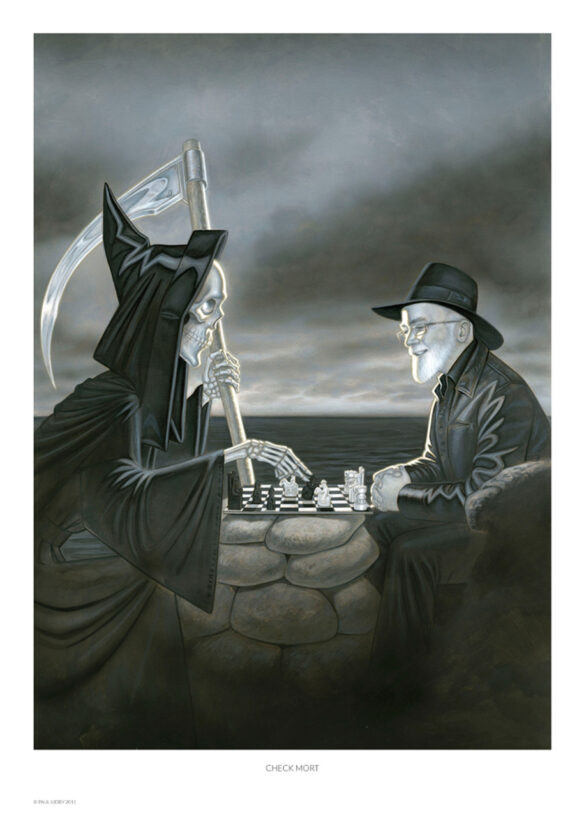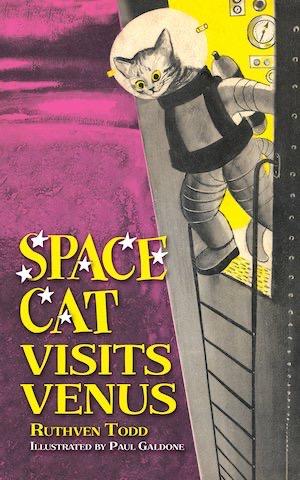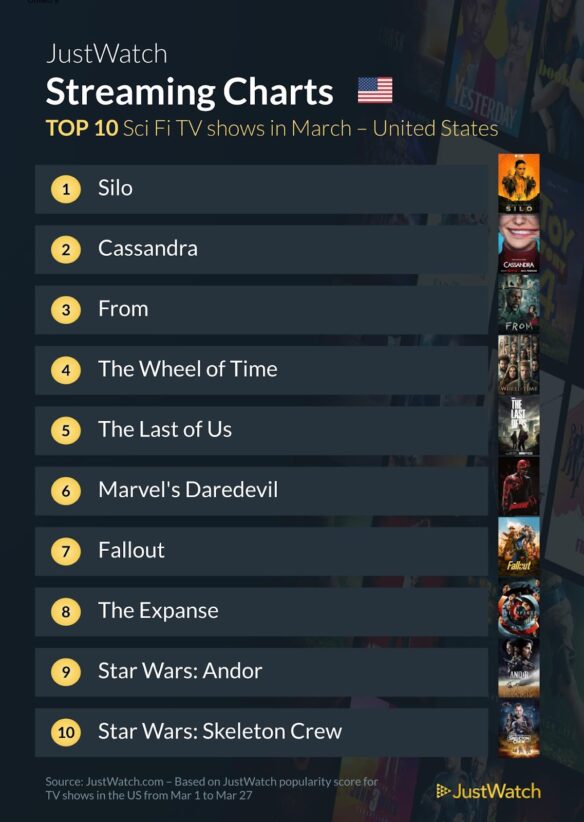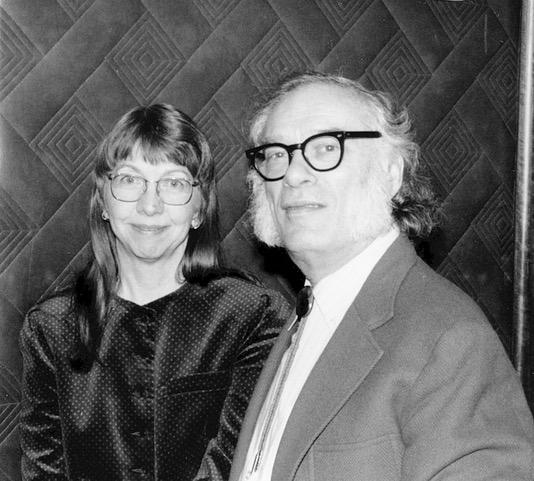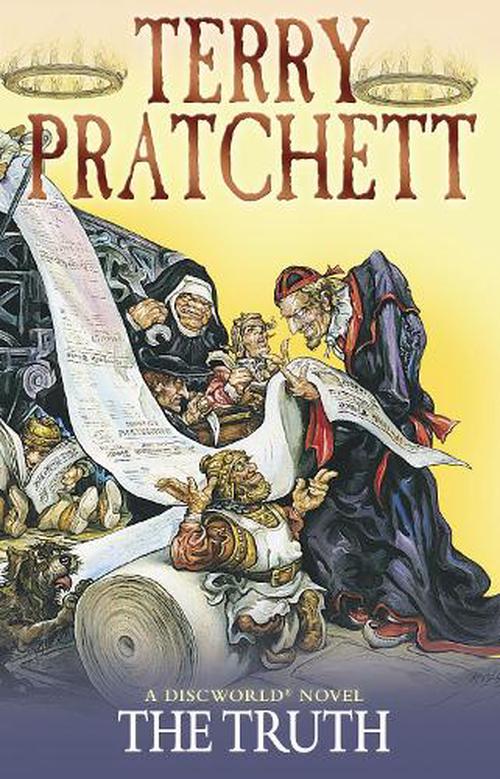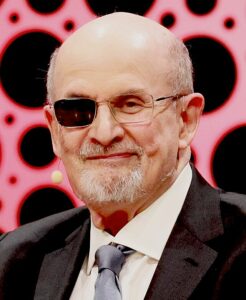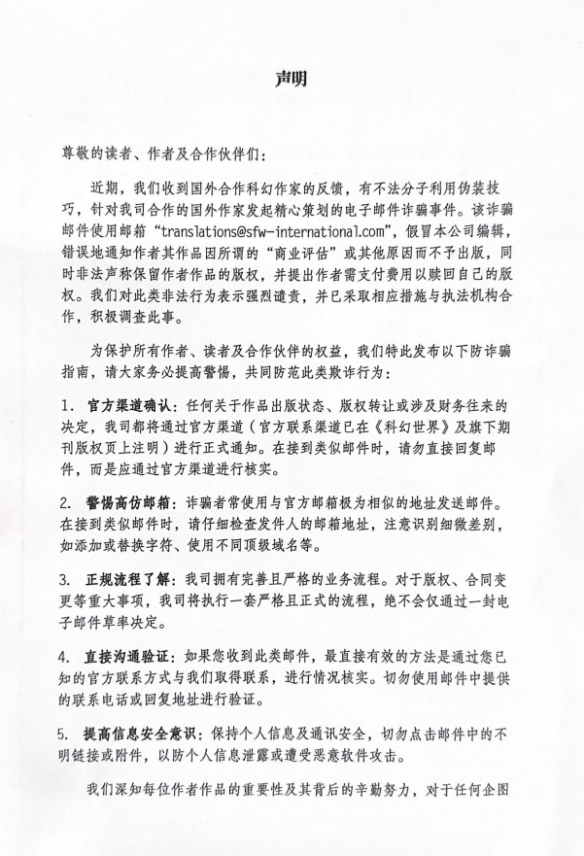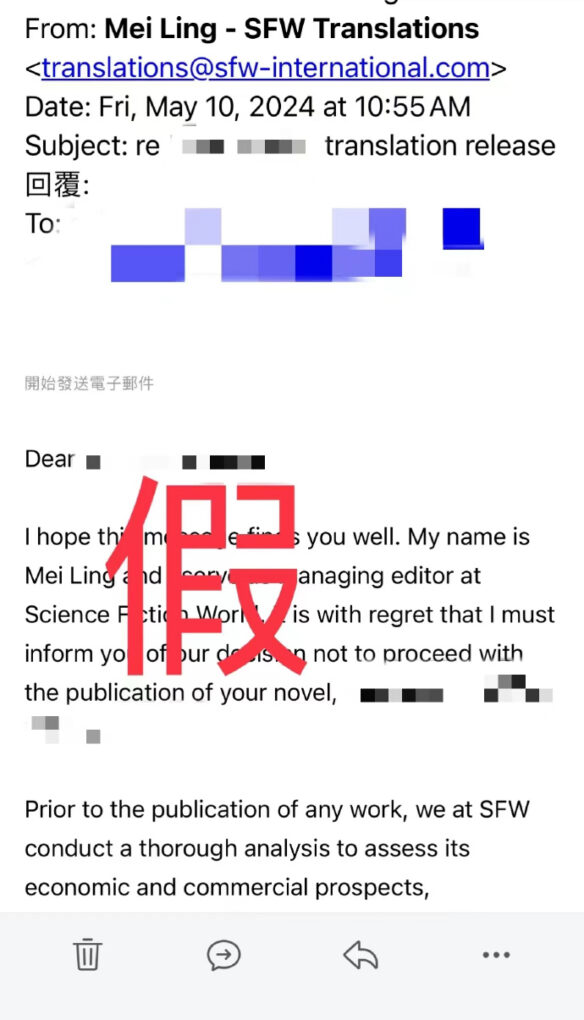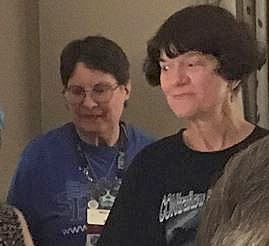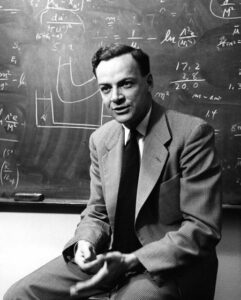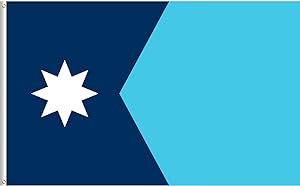(1) PARDON MY FRENCH. Mental Floss remembers “When Isaac Asimov Decided to Secretly Write Under the Name Paul French”.
If there was one author Henry Bott disliked more than any other, it was Isaac Asimov.
Bott, a book reviewer for the science fiction publication Imagination, had spent years lobbing insults at the respected writer and his work. Of Asimov’s Second Foundation, published in 1953, Bott wrote that Asimov was “neither a writer nor a storyteller” and could churn out only “elephantine prose.” Second Foundation was, Bott observed, “not a good book.”
After another seemingly personal review followed, this one for The Caves of Steel, an irritated Asimov penned a fiery retort in which he referred to Bott as “The Nameless One” in the fan publication Peon [PDF]. More volleys followed, and Asimov continued to take a shelling.
But when Asimov picked up the February 1955 issue of Imagination, he was amused to read Bott’s enthusiastic review of Lucky Starr and the Oceans of Venus, a spirited sci-fi adventure yarn that was part of an ongoing series by writer Paul French. The story, Bott effused, was gripping and worthy of a reader’s attention, though he felt it fell short of the young adult works by Robert Heinlein.
Asimov put the magazine down and began typing a letter to Imagination. This time, he would not attempt to argue with Bott. “I am sure that Mr. French, on reading this review, would feel quite good about the kind words and would feel no rancor at all about the eminently fair criticism,” Asimov wrote. “In fact, I am sure he would say he does his best to make his juveniles as good as Mr. Heinlein’s, and that perhaps he will improve as he continues to try.
“I am positive that Mr. French would say all this. The reason I am positive is that Paul French and Isaac Asimov are the same person.”…
It reminds me of the time Jerry Pournelle told us about a fan letter John W. Campbell received on the issue of Analog that contained one story by Pournelle and another under his pseudonym Wade Curtis. The fan’s verdict was: “Keep Wade Curtis but get rid of that Jerry Pournelle!”
(2) A POEM FOR BĴO.
By John Hertz: (reprinted from Vanamonde 1643) Learning that Bĵo Trimble was in the West Los Angeles Veterans Home, registered as Betty Trimble (Bĵo is short for Betty JoAnne), I sent her this.
Before others knew,
Enterprise was in your mind;
Talking, drawing, you
Took what could be to what was;
Yet humility, yet strength.
The ĵ in Bĵo is an Esperanto device indicating pronunciation bee•joe; her name has sometimes alas been written Bjo {i.e. without the circumflex over the j) – which, when I first saw it, I thought must be some Nordic name pronounced b’yo; she served in the United States Navy; the poem is an acrostic (read down the first letters of each line) in unrhymed 5-7-5-7-7-syllable lines like Japanese tanka.
(3) BAFTA TV AWARDS. Genre got totally shut out of the 2025 BAFTA awards (complete list of winners at the link).
One show of genre adjacent interest won the Specialist Factual category – Atomic People (BBC), which gathers the testimony of some of the last ‘Hibakusha’, survivors of the two atomic bombs the U.S. dropped on Japan in 1945.
(4) PARTS NOT UNKNOWN. In “A Tolkienian miscellany at Kalimac’s corner, David Bratman says another posthumous Tolkien publication is coming out this year.
If you’ve heard a rumor that yet another new book by JRRT is coming out, it’s true. The Bovadium Fragments will be appearing in the UK in October and in the US in November. “First-ever publication” as it says in the blurb is true, but “previously unknown”? Not a chance. As with some other posthumous Tolkien publication touted as “previously unknown,” its existence was first revealed in Humphrey Carpenter’s biography nearly 50 years ago. The Bovadium Fragments is mentioned there in a footnote as “a parable of the destruction of Oxford (Bovadium) by the motores manufactured by the Daemon of Vaccipratum (a reference to Lord Nuffield and his motor-works at Cowley) which block the streets, asphyxiate the inhabitants, and finally explode.” Which makes it something of a pair to an almost incoherently angry alliterative poem about motorcycles, written probably over 40 years earlier, which is no. 63 in the Collected Poems published last year, and which I think was previously unknown.
(5) CHRISTIE REANIMATED. “Agatha Christie, Who Died in 1976, Will See You in Class” reports the New York Times (behind a paywall).
Amelia Nierenberg, who reported from London, considers “The Murder of Roger Ackroyd” to be one of the greatest books ever written.
Agatha Christie is dead. But Agatha Christie also just started teaching a writing class.
“I must confess,” she says, in a cut-glass English accent, “that this is all rather new to me.”
The literary legend, who died in 1976, has been tapped to teach a course with BBC Maestro, an online lecture series similar to MasterClass. Christie, alongside dozens of other experts, is there for any aspiring writer with 79 pounds (about $105) to spare.
She has been reanimated with the help of a team of academic researchers — who wrote a script using her writings and archival interviews — and a “digital prosthetic” made with artificial intelligence and then fitted over a real actor’s performance.
“We are not trying to pretend, in any way, that this is Agatha somehow brought to life,” Michael Levine, the chief executive of BBC Maestro, said in a phone interview. “This is just a representation of Agatha to teach her own craft.”
The course’s release coincides with a heated debate about the ethics of artificial intelligence. In Britain, a potential change to copyright law has frightened artists who fear it will allow their work to be used to train A.I. models without their consent. In this case, however, there is no copyright issue: Christie’s family, who manage her estate, are fully on board.
(6) FOR CERTAIN VALUES OF INFLUENCE. The Notion Club Papers – an Inklings Blog argues “Charles Williams Did influence JRR Tolkien’s writing – The Place of the Lion and The Notion Club Papers”.
For the past fifty years it has been normal to assume that JRR Tolkien disliked (probably because he was jealous of) Charles Williams; and that Williams did not influence Tolkien’s writing.
Despite that Tolkien personally claimed such things in writing; none of these are strictly correct.
Tolkien was good friends with Williams, during Williams’s life – it was only some years after Williams died, when Tolkien became aware of some aspects of CW’s biography, that Tolkien turned against Williams and began to make misleading statements to play-down their friendship.
The denial of Williams’s influence on Tolkien is more complex. As a generalization, it is true to say that the two men had different minds, aims, and literary styles – and there is no striking influence of Williams noticeable in the works Tolkien published during his lifetime – especially not The Lord of the Rings.
But more can be said….
… It seems to me very likely that Tolkien’s writing of The Notion Club Papers was a direct consequence of the death of Charles Williams.
The Williams derivation is seen firstly in the origins of the NCPs as a playful “alter-ego” discussion group, explicitly referencing The Inklings, read to The Inklings as work-in-progress in instalments, and with characters loosely-based on the post-Williams membership.
In this respect I regard it as significant that there is no Notion Club member who is described as based-on the just-deceased Charles. It is as if the NCPs was a tribute to Charles’s memory, and as such to include CW among the somewhat facetious caricatures the NCP membership would have been disrespectful and altogether inappropriate. …
(7) WHERE TO START WITH PRATCHETT? Christopher Lockett begins a “Discworld Reread #1: The Colour of Magic and The Light Fantastic” at The Magical Humanist.
…Before I get into the novels proper, I feel it behoves me to address the perennial Discworld question: where to begin? I am starting at the beginning here and going in sequence for two reasons: (1) I want to be systematic and not haphazard about this, and (2) I want to watch Discworld develop and grow as I go.
But then, this is not the ideal way to approach Discworld if you’re just starting.
There are forty-one novels in total, but even though we refer to the Discworld series, it’s really not. Not a series, I mean … not in the sense of being serial, at any rate, wherein each instalment picks up where the last left off, and to have a grasp on the overarching story you must begin at the beginning and read in sequence.
That is not how Discworld works. As I’ve noted in this space previously, when asked by newbies what Discworld novel to start with, the lion’s share of Sir Terry devotees emphatically recommend against starting at the beginning…
Lockett follows with a chart of all the books that looks just one step away from being a Tom Gauld cartoon.
(8) MEMORY LANE.
[Written by Cat Eldridge.]
So Weird series (1999)
The considerable joy of doing these anniversaries is finding these series that I’ve never heard of. So it is with a Disney series called So Weird which ran for sixty-five episodes. So Weird could best be described as a younger version of the X-Files and it far darker than anything which was on Disney when it debuted in 1999. It lasted for just three seasons.
It was centered around teen Fiona “Fi” Phillips (played by Cara DeLizia) who toured with her rocker mom Molly Phillips (played by Mackenzie Phillips). They kept running into strange and very unworldly things. For the third and final season, she was replaced by Alexz Johnson playing Annie Thelen after the other actress gets the jones to see if she could make in Hollywood. (Well she didn’t.)
The story is that one of the characters, Annie, while visiting an Egyptian museum encounters a cat who once belonged to Egyptian queen that now wants her very much missed companion back. Yes, both the cat and the princess are either immortal or of the undead.
The writer of this episode, Eleah Horwitz, had little genre background having written just three Slider episodes and a previous one in this series. He’d later be a production assistant on ALF.
Now if you went looking to watch So Weird’s “Meow” on the Disney service after it debuted, that service which is not Disney+ originally pulled the second season within days of adding the series but returned it a month later within any reason for having pulled it. The show has never been released on DVD.
However the first five episodes in the first season of the series were novelized and published by Disney Press as mass-market paperbacks, beginning with Family Reunion by Cathy East Dubowski. (I know the Wiki page says Parke Godwin wrote it but the Amazon illustration of the novel cover shows her name. So unless this is one of his pen names, it is not by him.) You can find the other four that were novelized in the Amazon app by simply doing So Weird + the episode name. No they are not available at the usual suspects.
I didn’t find hardly any critics who reviewed it, hardly surprising given it was on the Disney channel but those that did really liked it including John Dougherty at America: The Jesuit Review: “As a kid, my favorite show was about death. Well, not just death: it was also about faith, sacrifice and trying to make sense of life’s ineffable mysteries. Strangest of all, I watched it on the Disney Channel. ‘So Weird’ ran for three seasons from 1999 to 2001. It was Disney’s attempt to create a kid-friendly version of ‘The X-Files,’ tapping into an in-vogue fascination with ghosts, alien encounters and other paranormal phenomena. In practice, it became something more: a meditation on mystery and mortality.”
I think I’ll leave it there.
For those of you with Disney+, it’s streaming there.

(9) COMICS SECTION.
- Arlo and Janis celebrates credentials through time.
- Baldo’s Gracie recreates a memory.
- Bizarro illustrates a weird crossover.
- Carpe Diem wants rover to come over.
- Ink Pen exposes the problem with homonymic heros.
- Mother Goose and Grimm has a horror malaprop.
- Saturday Morning Breakfast Cereal didn’t start out to be a vocational course.
- The Other Coast’s subjects know they’re being observed.
(10) ALAN MOORE Q&A. At Alan Moore World: “Long London, Magic & the future of Humanity”.
…In many of your works, Imagination or the Elsewhere often invades Reality. We see this, obviously, in Long London, Providence, Promethea, the League, the story about Thunderman in Illuminations, and so on. Often the world of Imagination influences or interferes, when it does not directly override, the Real one. Could you elaborate on the interconnected relationship between Reality and Imagination, and how your concept of Idea-Space and Magic is linked to it?
Alan Moore: I have to start by carefully defining what is meant by the term ‘reality’. It seems to me that what you most probably mean is material reality. My own position is that while we are indeed apparently part of and surrounded by a material reality (I say apparently because we all compose material reality moment by moment on the loom of our perceptions and are unable to prove that it is actually there, this being the hard problem of consciousness), we are just as evidently part of and immersed in the immaterial reality of our own thought processes. Since material science, which rightly requires empirical testing and repeatable experiments, cannot measure or meaningfully investigate human consciousness, it has tended to argue away consciousness as a ‘ghost in the machine’, and to insist that the only true reality is the material reality for which it has metrics and theories. This has percolated down into the ordinary person on the street’s default worldview, where to say that something is only happening in someone’s mind is to say that it isn’t happening, and by extension that our thoughts and inner workings are not real. Now, thanks to the hard problem of consciousness referred to earlier, while I cannot conclusively state that everybody else’s thoughts and inner workings are real, I can assure you that mine definitely are. In fact, again thanks to the hard problem of consciousness, my thoughts and inner workings are the only things in all existence that I know to be real. The imagination is the sole phenomenon that we know not to be imaginary….
(11) YESTERDAY’S SCALZI BIRTHDAY CELEBRATION. That was clever.
(12) CONAN OUTSIDE THE BOX. “Frazetta Icon Collectibles Conan 1:12 Action Figure Demo”.
As FrazettaGirls designer and project manager I am proud to invite you to join me at the Coffee table for an exciting unboxing and demonstration of the upcoming Frazetta Icon Collectibles Action Figure, Conan The Barbarian!
(13) WHAT IS THE WEIRDEST FILM EVER MADE? [Item by SF Concatenation’s Jonathan Cowie.] Moid Moidelhoff over at Media Death Cult asks this question over three days of weed-enhanced film watching. He comes up with a few recommendations and also asks cult members to provide their suggestions in the ‘comments’ (worth having a skim). In the process, he scares himself sh*tless and has a nervous breakdown… But he comes up with some interesting choices including a previous film by the folk behind the Hugo-winning Everything, Everywhere, All at Once and also the best killer tyre film of all time. You can see the 21-minute video here:
[Thanks to Mike Kennedy, Andrew Porter, John King Tarpinian, Chris Barkley, Cat Eldridge, SF Concatenation’s Jonathan Cowie, Mark Roth-Whitworth, Steven French, Kathy Sullivan, and Teddy Harvia for some of these stories. Title credit belongs to File 770 contributing editor of the day Paul Weimer.]

